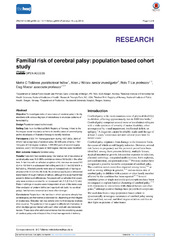| dc.contributor.author | Tollånes, Mette Christophersen | en_US |
| dc.contributor.author | Wilcox, Allen James | en_US |
| dc.contributor.author | Lie, Rolv Terje | en_US |
| dc.contributor.author | Moster, Dag | en_US |
| dc.date.accessioned | 2014-12-23T08:27:39Z | |
| dc.date.available | 2014-12-23T08:27:39Z | |
| dc.date.issued | 2014-07-15 | eng |
| dc.identifier.issn | 0959-8146 | |
| dc.identifier.uri | https://hdl.handle.net/1956/9021 | |
| dc.description.abstract | Objective To investigate risks of recurrence of cerebral palsy in family members with various degrees of relatedness to elucidate patterns of hereditability. Design Population based cohort study. Setting Data from the Medical Birth Registry of Norway, linked to the Norwegian social insurance scheme to identify cases of cerebral palsy and to databases of Statistics Norway to identify relatives. Participants 2 036 741 Norwegians born during 1967-2002, 3649 of whom had a diagnosis of cerebral palsy; 22 558 pairs of twins, 1 851 144 pairs of first degree relatives, 1 699 856 pairs of second degree relatives, and 5 165 968 pairs of third degree relatives were identified. Main outcome measure Cerebral palsy. Results If one twin had cerebral palsy, the relative risk of recurrence of cerebral palsy was 15.6 (95% confidence interval 9.8 to 25) in the other twin. In families with an affected singleton child, risk was increased 9.2 (6.4 to 13)-fold in a subsequent full sibling and 3.0 (1.1 to 8.6)-fold in a half sibling. Affected parents were also at increased risk of having an affected child (6.5 (1.6 to 26)-fold). No evidence was found of differential transmission through mothers or fathers, although the study had limited power to detect such differences. For people with an affected first cousin, only weak evidence existed for an increased risk (1.5 (0.9 to 2.7)-fold). Risks in siblings or cousins were independent of sex of the index case. After exclusion of preterm births (an important risk factor for cerebral palsy), familial risks remained and were often stronger. Conclusions People born into families in which someone already has cerebral palsy are themselves at elevated risk, depending on their degree of relatedness. Elevated risk may extend even to third degree relatives (first cousins). The patterns of risk suggest multifactorial inheritance, in which multiple genes interact with each other and with environmental factors. These data offer additional evidence that the underlying causes of cerebral palsy extend beyond the clinical management of delivery. | en_US |
| dc.language.iso | eng | eng |
| dc.publisher | BMJ | eng |
| dc.rights | Attribution-NonCommercial CC BY-NC | eng |
| dc.rights.uri | http://creativecommons.org/licenses/by-nc/3.0/ | eng |
| dc.title | Familial risk of cerebral palsy: Population based cohort study | en_US |
| dc.type | Peer reviewed | |
| dc.type | Journal article | |
| dc.date.updated | 2014-12-23T08:19:44Z | |
| dc.description.version | publishedVersion | en_US |
| dc.source.articlenumber | g4294 | |
| dc.identifier.doi | https://doi.org/10.1136/bmj.g4294 | |
| dc.identifier.cristin | 1185935 | |
| dc.source.journal | BMJ (British Medical Journal) | |
| dc.source.40 | 349 | |

